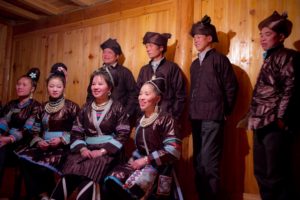GA LAO
Unaccompanied choral traditions of China’s Dong People
By Li Xi, choral conductor, China
I first encountered the singing of the Dong People which they call Ga Lao in 2006 during the World Choir Games in Xiamen. When a line of beautiful Dong girls dressed in their traditional Dong dresses was advancing slowly into the stage, the singing was so pure that it seemed the voices were coming down from heaven. I was so captivated by this chorus that I decided to go to the birthplace of this amazing music – Liping, to further experience it myself. Liping County lies on the edge of the Guizhou Province in South China. Now I would like to introduce this treasure of Chinese culture to choral music lovers around the world.
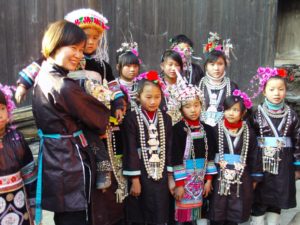
Legend says that the Dong people are descendants of the ancient Yue people, who have a 2500 year history. There are three legendary treasures of the Dong culture: the Flower Bridges, the Drum Towers and Ga Lao.
The Guizhou Karst geology consists of many easily accessible caves — warm in winter and cool in summer. The people of this region were called the cave people because they lived in these caves and Dong stems from the Chinese word for cave. The Dong singing traditions began through the imitation of sounds they heard in the caves. Since the Dong language has no written form, Ga Lao is taught orally and handed down from generation to generation. Therefore, Ga Lao symbolizes the national culture and upholds the cultural heritage.
The Dong people believe that food nourishes the body but singing nourishes the heart. In other words, Dong people think of ‘songs’ and ‘rice’ as equally important to their life. The singing is used as a kind of spiritual energy that they use to mold their character and their soul.
Young men and women use singing as a means of courting. When night comes, boys sing songs and invite girls to sing together under the moon. This activity is called Xing Ge Zuo Yue. They express their love and choose a life partner by singing together.
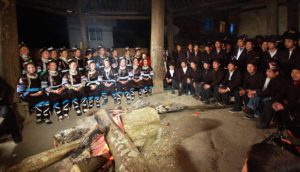
The main subjects of the choruses are nature, labor, love and friendship. Simulating the sounds of birds and insects, mountains and streams and other natural sounds is one of the characteristics of the Dong tradition. Ga Lao songs are composed by people performing daily rituals.
The characteristic hallmarks of Ga Lao include three-voiced structures that use drones (i.e., sustained sonorities), parallel singing and imitation.
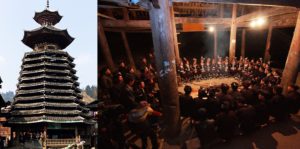
The main melody is usually presented in the lower voices and is in the forefront. The soprano or tenor parts are derived from the main melody and sung by one or a small group singers. The upper voices usually improvise a melody above the primary material in the alto or bass part. However, the soprano or tenor will sing the main melody when the lower voice holds a long sustained low passage.
Choristers receive rigorous training in traditional ways from an early age where they develop appropriate tone quality, flexibility, rhythm, independence, and memorize an extraordinary number of songs. There is a training system in every village and involves villagers of varying genders and ages in four basic groups—Young Children’s Choir (Treble), Youth Choir (Mixed), Adult Choir (Men), and Senior Choir (Mixed). Young Children’s Choir members range from 8 to 12 years of age and stay several years in this ensemble. The Young Children’s Choir occasionally demonstrate Ga Lao during festivals or when there are visitors, but they are mainly an apprentice group. The Youth Choir members range from 17 to 25 years old and this ensemble serves as the main performing choir.
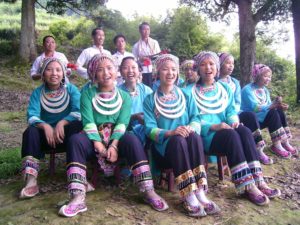
The Adult Choir is comprised of married men as female choristers must leave the choir when they get married. Whenever the Youth Choir is unavailable, the Adult Choir performs.
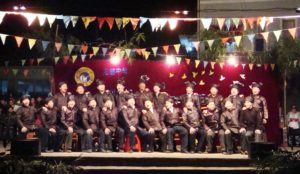
The Senior Choir is made up of older singers, usually grandparents. This ensemble performs ballads and polyphonic chants to demonstrate for the younger ensembles, but do not perform formally.
Classification of Dong Chorus
According to their style, rhythm, subject matter, performance style and their social role, Ga Lao can be divided into the following types:
Gating means “Sounds Songs” which are comprised of improvised melodies with very brief lyrics. The songs often have some prominent elongated chants prior and following the actual lyrics. Several singers sing counterpoint in the soprano or tenor voice. All of the alto or basses sing a contrasting drone and the songs often imitate the sounds of nature: insects, birds, or water in the river.
(Click on the image to download the full score)
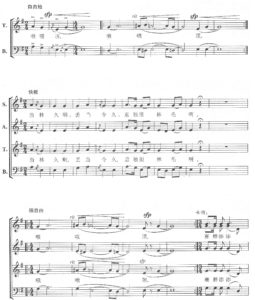
Gaxiang are “Ethics Songs” and serve as educational pieces. The songs have short undulating melodies, focusing on the content of the text which praise or critique social morals of the Dong people.
(Click on the image to download the full score)
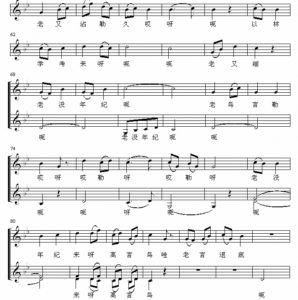
Work Songs: Dong people also sing together when they are growing weary of their labor. These kinds of songs are called Work Songs.
(Click on the image to download the full score)
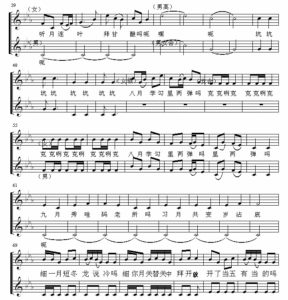
Worship Songs. The Grandmother is the most admired deity figure in Dong culture. They call their Grandmother Sa. Dong people hold a great ceremony to worship Sa on every January 3rd of the lunar new year. All of the Dong people sing the worship songs together in this activity.
There are general popular group activities in the Dong villages which have three names: Waihei, Waiding, and Waike. When all the people in a village visit another village and sing together this is called Waihei.
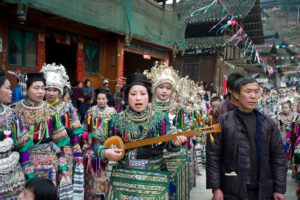
Sometimes the young people in the two villages will meet socially to sing choruses together, and this is called Waiding.
When family or friends visit together and sing Dong choruses, this is called Waike.
Caitang Songs. When the party is nearing a close, Dong people hold hands while dancing and singing.
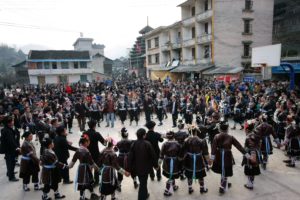
(Click on the image to download the full score)
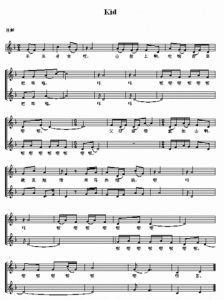
Apart from these types of Ga Lao, there are still more songs in the categories of Road Stopping Songs, Love songs, Story-telling ballads, Drinking Songs, Wedding Songs and Funeral Songs.
Each song category features different melodies, lyrics and style. Dong people rarely repeat the same song. Every Dong music teacher holds several thousand different songs in his or her memory. The Ga Lao songs are intertwined with Dong culture, traditions and everyday life. With so many people who love singing it is no wonder the Dong villages are called the “Sea of Songs and the Home of Poems”.
Introducing Dong GA LAO traditions to the world
Liping County Dong Choir performed in Beijing in October 1959—their first time singing outside of the Dong village. Their performances invoked great excitement and inspired further performance invitations. This was an important step for the tradition of Ga Lao—to be sent out from the mountains to the rest of the world. To date, they have performed in France, Italy, Germany and Singapore to share their traditional repertoire. On October 3, 1986, Liping County Dong Choir attended the Paris Autumn Festival. Their performance in Palais de Chaillot was so well-received that it received 37 standing ovations. Executive Chairman M. Josephine, said: “It is rare in the world that a minority group of people with only over two million people can create and preserve such an ancient and pure folk chorus”.
Many people had incorrectly thought that China had no harmony in its music, but the Dong people’s Ga Lao reveals the polyphony in ancient China. Thanks especially to the work of choral conductor Yin-Ting Sun, the tradition continues to thrive.
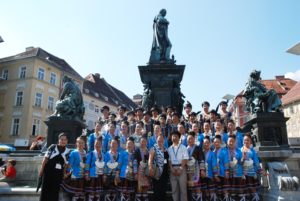
Edited by Cara Tasher, USA
